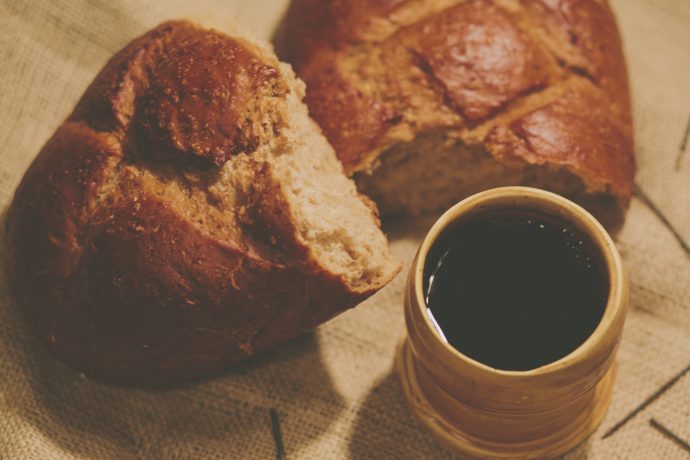When I was growing up as a pastor’s kid in the Church of the Nazarene, we dedicated our babies, baptized our preteens, and received Communion four times a year. But in recent years, I have observed a growing desire for sacramentally centered worship and spirituality. Many churches are celebrating Communion more frequently (we even updated the Manual to encourage this!), becoming more open to infant baptism, and embracing various elements of historic Christian liturgy, such as confession, the creeds, observance of the Christian calendar, and the use of the lectionary. I believe this is a move of the Holy Spirit to renew and revive the church and deepen our faith. The following is a sacramental theology in outline for those who wish to think more deeply about the sacraments or for those who wonder what all the fuss is about.
1. All God created is good. No discussion of sacraments or sacramentality can begin anywhere other than where the great creeds of the church begin: I believe in God, the Father Almighty, Creator . . .” God’s first self-revelation in Scripture is in the Spirit-sourced act of creating, of speaking the world (kosmos) into existence through the Word (logos) in an outpouring of love that need not have been. God utters, and it is. This same God forms humankind (‘adam) from the stuff of creation—the earth, the ‘adamah. God blesses all creation, naming it “good.”
2. Matter matters to God. God cares about creation. “For God so loved the world [kosmos]” . . . Even after the fall, God’s response is that of a loving Father, disappointed that his offspring fail to trust him. Sin, then and now, is its own consequence, the effects of which extend to all of creation. But because matter matters, God’s business is not cursing, but the work of blessing and restoring that which he created. Therefore, Christianity is a physical, and not a merely spiritual, religion. God cares not only about our souls but also about our bodies and what we do with them.
3. God redeems through matter. After God created matter, God continues to interact with and even act through it. A quick sampling from the Old Testament shows God working through a burning bush; through waters that open for the children of Israel and collapse to engulf the Egyptian oppressors; through pillars of cloud and fire; through manna in the wilderness. But nowhere is this truth more evident than in the conception by the Holy Spirit of the promised Messiah in the womb of an ordinary peasant girl. Theologians refer to this moment as the incarnation—not simply the “nativity” (birth) of Jesus, but even backing up nine months to the angel’s annunciation to Mary, celebrated in the Eastern church on March 25 as the Feast of the Incarnation. This is the moment of in-carne—God-in-flesh. God’s redemptive work hinges on the messy materiality of the bodily life, ministry, death, resurrection, ascension, and second coming of the Jesus, the crucified and risen Lord.
4. Sacraments are God’s love language. The way our God elects to work—God’s modus operandi—is through the material order of that which God created. So while we await the second coming of Christ, God has provided the sacraments as “means of grace”—channels, vehicles, conduits, ordinary ways God extends grace to humankind. Catholic theologian David Power calls the sacraments “the language of God’s giving.” In baptism and communion—and in the broader Christian tradition, healing, reconciliation, marriage, ordination—God shows us what love looks like by offering us amazing grace, the healing presence of Christ through simple symbols drawn from the ordinary “stuff” of creation.
5. Christ is the original sacrament. In other words, the sacraments all find their meaning in the story, the person, and work of Jesus Christ. All the sacraments flow out of God’s original “sacramental” act in the Christ event. While the ascended Christ is, according to the creeds, “seated at the right hand of the Father” and we await his coming again, we have understood two material “things” to extend Christ’s physical presence here on earth: the body of Christ called church and the bread and wine of Communion. These two are intertwined. The church becomes the body of Christ as it gathers at the table for Communion. The bread and wine become the body of Christ in that they allow us to share spiritually in Christ’s glorified body. Without Christ, the church is nothing more than a pious social club, and the Communion elements are just a rather unappetizing snack.
6. Baptism is the sacrament of initiation. In our culture, we have reduced baptism to something like a personal testimony with a little water added. But historically, baptism was regarded as entrance into the church. To the early church, the idea of an unbaptized Christian was simply unthinkable. To be Christian meant being welcomed into the church through baptism, whereby we participate bodily in the death and resurrection of Jesus. The reason many traditions prefer baptism by “full immersion” is that it captures well the symbolism of dying and being buried with Christ and then being raised up again to new life. The “old man” (or woman) remains in the watery grave; in Christ, all has been made new. The church has long understood that the only way into the family of God is through Christ’s death and resurrection. We materially, tangibly, enact and receive this blessing by submitting our bodies to the waters of baptism.
7. Communion is the sacrament of sanctification. Growing up in the church of the Nazarene, I experienced a great emphasis on personal holiness and sanctification; we also took a rather narrow view of Communion and consequently missed out on its relevance to the sanctified life. The only symbolic connection I recall was between the bread and wine (grape juice, in our case) and Christ’s sacrifice on Calvary. Of course, the cross is the central symbolic referent of the Lord’s Supper, but we may discover several other “layers” of meaning as well. Also known as Eucharist, this meal is food for the journey, nourishment for the Christian life, and a foretaste of the heavenly feast (more on this later). It also symbolizes our communion (koinonia) as the community of faith—those Christ has gathered and bound together by his love. Through the Holy Spirit’s transforming power, God is making us more into the image and likeness of Jesus, setting us apart to be Christ’s ambassadors of reconciliation in the world.
8. God’s grace is not limited to the sacraments. While Christians traditionally recognize certain corporate actions as “sacraments” in an official sense, God also uses other practices to convey grace and nurture spiritual growth. In the Wesleyan tradition, we call these disciplines “means of grace”: prayer, Scripture study, fasting, Christian fellowship, acts of compassion, and so on. God may also communicate grace through a cup of coffee, a walk in nature, a lover’s kiss, bathing an infant, songs sung around the bed of a dying saint, washing the dishes . . . imagine if we could recognize God’s presence in all of it?
9. Sacraments drive us toward mission. Christ commanded his followers to “go into all the world and make disciples, baptizing them . . .” (Matt. 28:19). We who are baptized have work to do! Baptism is like the “universal ordination” of all Christians to the ministry. Before anyone is ordained as clergy, to be priests for the church, we are all ordained through baptism to be priests for the world. As Augustine of Hippo reminded a group of the newly baptized, in Communion we receive what we are. We who have received at Christ’s table have something to offer the world, “in remembrance” of Jesus, who ate with sinners and equated himself with “the least of these.” The goal of our worship is mission—like the Communion elements, allowing ourselves to be taken, blessed, broken and then sent forth to be given for the life of the world. And the goal of mission, reciprocally, is worship—to take worship to those places where it presently does not exist.
10. Sacraments point us toward the kingdom. Baptism symbolizes new birth, reversing the effects of the fall—creation “set to rights” (to use N. T. Wright’s phrase) and restored according to God’s intention. Communion points back to the upper room and the cross and points forward to the marriage supper of the Lamb, an appetizer before the heavenly banquet. While we await this endless party to end all parties, we get a foretaste of Christ’s real presence in these rich symbols—never “mere” symbols, but outward and visible signs of inward grace. Now we see through a glass darkly, walking by faith; then we shall see him face-to-face.






3 Comments
James
Thanks for your thoughts words.
Peter van Duinen
Brannon Hancock and I have had many discussions about sacramental theology and how my Salvationist perspective on the subject may add a (often overlooked) richness to the life of Holiness. A well articulated presentation of Salvationist sacramental theology can be found here: https://salvationist.ca/articles/2012/08/the-real-sacrament/
Angela Murray
Love the thoughts and truth shared here. I especially like #4.